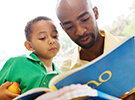Rub a Shape
In this lesson, children will make rubbings of foam board shapes.
Lesson for:
Toddlers/Preschoolers
(See Step 5: Adapt lesson for toddlers or preschoolers.)
Content Area:
Geometry
Learning Goals:
This lesson will help toddlers and preschoolers meet the following educational standards:
- Analyze characteristics and properties of two- and three-dimensional shapes and develop mathematical arguments about geometric relationships
Learning Targets:
After this lesson, toddlers and preschoolers should be more proficient at:
- Recognizing, naming, building, drawing, comparing and sorting two- and three-dimensional shapes

Rub a Shape
Lesson plan for toddlers/preschoolers
Step 1: Gather materials.
- Foam board shapes (circle, triangle and square—make your own)
- White or manila paper (8½ x 11)
- Chubby crayons (with paper removed)
- Transparent tape
- The book, Dinosaur Shapes by Paul Stickland
Note: Small parts pose a choking hazard and are not appropriate for children age five or under. Be sure to choose lesson materials that meet safety requirements.
Step 2: Introduce activity.
- Cut similar-sized foam board shapes (circle, triangle and square).
- Read, Dinosaur Shapes by Paul Stickland (or another appropriate book to introduce the topic).
- Show the children the foam board shapes, one at a time.
- Ask the children what they notice about each shape.
- Pass each shape around so that each child can feel the edges while you help describe its attributes. (For example, “The triangle has three sides and three corners.”)
- Say: “We are going to use our crayons to make these shapes magically appear!”
Step 3: Engage children in lesson activities.
- Tape the foam shapes on a table (one shape by each chair).
- Tape a piece of paper over each shape (one small piece of tape on the top of the paper and one small piece of tape on the bottom of the paper).
- Say: “There is something hiding under this paper. We are going to be detectives to find out what it is.”
- Show the children how to rub a crayon on its side all over the paper.
- Say: “Let’s feel the sides and points with our fingers and predict what shape is under the paper. Then we can rub our crayons over them to see which shape is under the paper and check our predictions.”
- When the shape is revealed, say: “How many sides and points does your shape have? Do you know what shape it is?”
- Remove the paper and replace it with a blank sheet of paper. Let the children move to another chair to rub a new shape.
Step 4: Vocabulary.
- Triangle: A pointy shape with three sides and three corners (e.g.,”A slice of pizza is a triangle.”)
- Square: A shape with four straight sides (that are the same length or size) and four corners
- Circle: A round shape that has no straight edges or corners (e.g., “A wheel is a circle.”)
- Rectangle: A shape with four sides and four right angles
- Oval: A stretched-out circle that is shaped like an egg
- Hexagon: A shape with six straight sides and six corners (e.g.,”A stop sign is a “hexagon.”)
Step 5: Adapt lesson for toddlers or preschoolers.
Adapt Lesson for Toddlers
Toddlers may:
- Take the paper off of the shape to see what is underneath
- Hold the crayon upright and scribble on the paper
Child care providers may:
- Let the children see and feel the shape underneath, then cover it up again with the paper
- Put their hand over the child’s hand to demonstrate rubbing
Adapt Lesson for Preschoolers
Preschoolers may:
- Rub more complex shapes (e.g., rectangle, hexagon, etc.)
- Use the foam shape for tracing
- Cut out the rubbed shape
Child care providers may:
- Cut more complex shapes from the foam board and continue the activity using these shapes
- Untape the foam shapes and let the children use them as stencils for tracing
- Give the children scissors to cut out their rubbings
Suggested Books
- Dinosaur Shapes by Paul Stickland (New York, NY: Sterling, 2009)
- My Very First Book of Shapes by Eric Carle (New York, NY: Philomel, 2005)
- A Circle Here, A Square There by David Diehl (New York, NY: Lark Books, 2007)
- Shapes, Shapes, Shapes by Tana Hoban (New York, NY: Greenwillow Books, 1996)
Music and Movement
- “Circles Go Round and Round” from We Love Math with Miss Jenny
- “Shape Train” by Ron Brown
- “Shapes All Around Us” from Music, Movement and Magination
- “Marmot’s Map Shapes“
- “Shapes Song for Kids“
Outdoor Connections
- Go on a shape hunt outdoors. Walk around the block looking for circles, squares and triangles all around you. Take photos of the shapes that you see so that you can make a neighborhood shape book with the children later.
- Play shape hopscotch. Draw a hopscotch board on your sidewalk with chalk. Draw shapes in each box. Tell the children to take turns jumping on each of the shapes and calling out the name of each shape that they land on.
Comment on this lesson